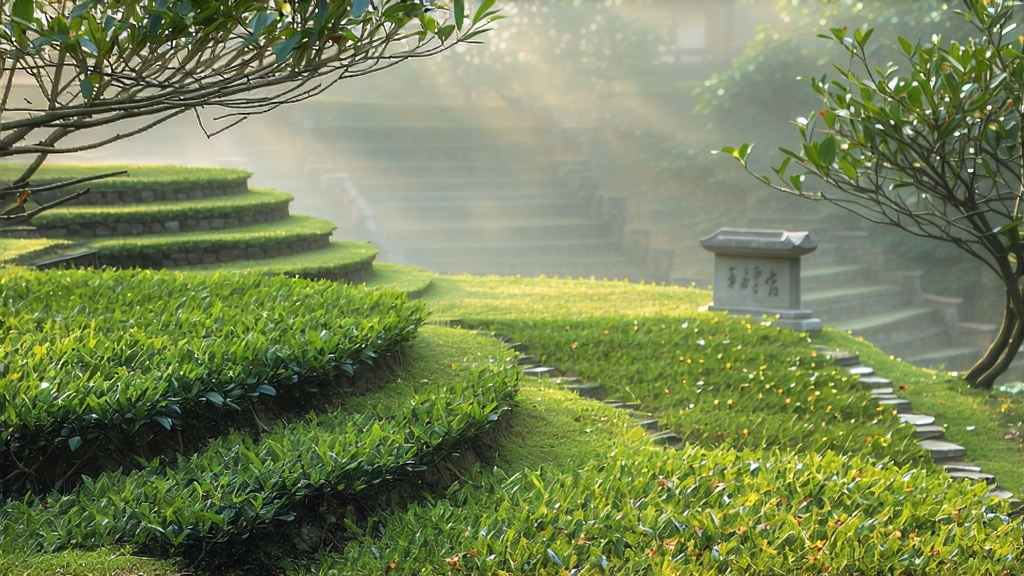
Meng Ding Huang Ya, literally “Yellow Bud from the Summit of Meng,” is the least-traveled treasure of China’s six major tea families. While green tea’s jade freshness and pu-erh’s post-fermented depth have conquered foreign shelves, this yellow tea remains a quiet legend, guarded by 3,000-year-old terraces that rise above the Sichuan basin like the vertebrae of a sleeping dragon. To understand it is to step into a micro-climate where 280 foggy days a year slow photosynthesis to a whisper, concentrating amino acids into a sweetness that emperors once rationed by the gram.
History: from elixir to etiquette
The first written record appears in a Han-dynasty stone inscription dated 53 BCE, describing a “golden sprout” offered to the sick mother of governor Wu Lizhen, who later planted seven tea bushes on Meng Ding peak. By Tang times the buds were taxed as “tribute of the fifth rank,” and Song emperor Huizong—himself a skilled tea artist—decreed that only virgins with golden scissors could pick them before the Qingming festival. Caravans carried the tea southward on the Tea-Horse Road, exchanging it for Tibetan warhorses, while poets compared its liquor to “the first moonlight on melted snow.” After the fall of the imperial system in 1911, the gardens lapsed into wild neglect until 1958, when a small state farm revived the craft to honor Chairman Mao’s gift to Nikita Khrushchev; even then, annual production never exceeded 300 kg, most of it locked in Beijing’s state vaults.
Micro-terroir: why the mountain makes the color
Meng Ding sits at 29.9° N, 1,450 m above sea level, where the Min River funnels humid air against the Tibetan Plateau. Diurnal temperature swings of 15 °C force the tea plant to store extra theanine in its dormant buds; when dawn fog blocks UV-B rays, chlorophyll degradation is slowed, creating the pale jade-yellow leaf that gives yellow tea its name. The soil is a purple sandy loam rich in selenium and vanadium, trace elements that catalyze the formation of 3-methylbutanal, the same compound that lends Madagascar vanilla its creamy note. Because the mountain is a protected UNESCO geopark, no agro-chemicals have been applied since 1982; instead, farmers plant aromatic citronella grass between rows to repel leafhoppers, adding a faint citrus echo to the finished tea.
Plucking code: one bud, one leaf, one dawn
The harvest window opens on the first insect chirp after the spring equinox and closes exactly ten days later. Only the “flag-and-bud” shoot is taken: the unopened tip flanked by a single leaf shaped like a miniature spearhead. Pickers wear undyed cotton gloves to prevent skin oils from oxidizing the downy surface; the leaf is dropped into bamboo cylinders lined with fresh banana leaf, maintaining 90 % humidity so that cell membranes remain pliable for the crucial next step.
Craft: the art of “sealed yellowing”
Unlike green tea, which is immediately pan-fired to fix green color, Meng Ding Huang Ya is lightly killed-green at 120 °C for just 90 seconds—long enough to denature polyphenol oxidase but short enough to retain 15 % residual enzyme activity. The leaves are then wrapped in steamed rice paper and stacked inside a cedar box lined with wet linen. Over 48 hours the bundle is opened every six hours to release trapped CO₂, re-moistened with mountain spring water, and re-wrapped. This men-huang (“sealed yellowing”) allows non-enzymatic oxidation of catechins into theaflavins, turning the leaf a warm maize color and mellowing tannins into a honeyed roundness. Finally the tea is charcoal-baked using local dragon-eye wood whose resin imparts a whisper of longan fruit. The entire process consumes 7 kg of fresh leaf to yield 1 kg of finished tea, explaining its rarity.
Grades & styles
- Imperial Sparrow Tongue: the top 0.5 %, composed entirely of buds 12–15 mm long; when infused they stand upright like miniature golden pagodas.
- Fragrant Yellow Slice: one bud and one tiny leaf, flattened by hand in a wok at 80 °C to mimic the shape of a bird’s wing; prized for its orchid nose.